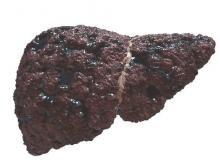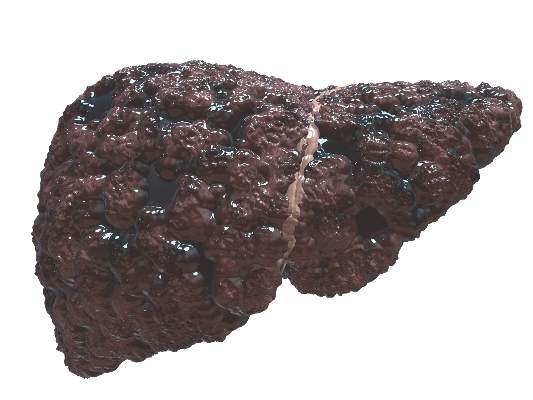User login
SAN FRANCISCO – Sustained virologic response (SVR) in patients with hepatitis C virus (HCV) infection is associated with large reductions in all-cause mortality and appears to eliminate liver-related mortality in those patients who achieve SVR before developing cirrhosis, according to a real-world study presented at the annual meeting of the American Association for the Study of Liver Disease (AASLD).
“This study strongly supports treatment and cure of HCV to reduce deaths in this patient population,” reported Dr. Lisa M. Nyberg, a specialist in hepatology at Kaiser Permanente, San Diego.
In this study, 24,968 patients diagnosed with HCV in the Kaiser Permanente health care system from January 2002 until the end of 2013 were evaluated retrospectively. The overall mortality over the course of follow-up was 18.5%, but the proportion of patients who died was higher in the group with cirrhosis (33.2%) versus those without cirrhosis (7.8%).
Of the 5,203 treated for HCV, 45.1% achieved SVR. The mortality rates were 18.9% in the absence of SVR versus 5.4% in those who achieved SVR. SVR was associated with reductions in all-cause mortality in those with cirrhosis (8.11% vs. 23.3%; P less than .0001) as well as those without cirrhosis (2.1% vs. 5.3%; P less than .0001).
When liver-related mortality was evaluated, SVR was again associated with large reductions in those with cirrhosis (24.7% vs. 41.9%; P less than .0001) as well as in those without cirrhosis (0% vs. 12%; P = .0178). Indeed, this latter finding indicates that SVR essentially eliminates risk of liver-related death in the absence of cirrhosis.
“The data suggest that treatment of HCV should be initiated at all stages of disease with the intention to cure HCV when possible before progression to cirrhosis,” said Dr. Nyberg, indicating that these findings are relevant to the debate about when to consider curative therapies.
However, Dr. Nyberg suggested that the significant reductions in death by any cause even in patients without cirrhosis suggest that HCV should be considered a systemic illness. She suggested that it is important to recognize that the benefit of eradication extends beyond complications in the liver.
The vast majority of SVRs were achieved in this study with interferon-based regimens, which typically have limited efficacy in many HCV subpopulations, such as those defined by viral genotype. During the discussion that followed presentation of these data, this was a criticism directed at the overall conclusion that SVR can be isolated as a factor in improved outcomes.
“Patients [who achieve SVR on interferon-based therapies] may be very different people to start with,” cautioned Dr. Hans L. Tillmann, professor of medicine, East Carolina University, Greenville, N.C. He pointed out that factors that influence the likelihood of achieving SVR on an interferon-based therapy might be associated with risk factors for mortality over time. With direct-acting antivirals, which have the potential to provide SVR in the vast majority of patients, “you may not be able to reproduce these outcomes.”
While acknowledging the relevance of this criticism, Dr. Nyberg reported that further study is ongoing, including efforts to consider severity of liver disease to evaluate the effect of SVR on the natural history of long-term liver complications following HCV infection.
SAN FRANCISCO – Sustained virologic response (SVR) in patients with hepatitis C virus (HCV) infection is associated with large reductions in all-cause mortality and appears to eliminate liver-related mortality in those patients who achieve SVR before developing cirrhosis, according to a real-world study presented at the annual meeting of the American Association for the Study of Liver Disease (AASLD).
“This study strongly supports treatment and cure of HCV to reduce deaths in this patient population,” reported Dr. Lisa M. Nyberg, a specialist in hepatology at Kaiser Permanente, San Diego.
In this study, 24,968 patients diagnosed with HCV in the Kaiser Permanente health care system from January 2002 until the end of 2013 were evaluated retrospectively. The overall mortality over the course of follow-up was 18.5%, but the proportion of patients who died was higher in the group with cirrhosis (33.2%) versus those without cirrhosis (7.8%).
Of the 5,203 treated for HCV, 45.1% achieved SVR. The mortality rates were 18.9% in the absence of SVR versus 5.4% in those who achieved SVR. SVR was associated with reductions in all-cause mortality in those with cirrhosis (8.11% vs. 23.3%; P less than .0001) as well as those without cirrhosis (2.1% vs. 5.3%; P less than .0001).
When liver-related mortality was evaluated, SVR was again associated with large reductions in those with cirrhosis (24.7% vs. 41.9%; P less than .0001) as well as in those without cirrhosis (0% vs. 12%; P = .0178). Indeed, this latter finding indicates that SVR essentially eliminates risk of liver-related death in the absence of cirrhosis.
“The data suggest that treatment of HCV should be initiated at all stages of disease with the intention to cure HCV when possible before progression to cirrhosis,” said Dr. Nyberg, indicating that these findings are relevant to the debate about when to consider curative therapies.
However, Dr. Nyberg suggested that the significant reductions in death by any cause even in patients without cirrhosis suggest that HCV should be considered a systemic illness. She suggested that it is important to recognize that the benefit of eradication extends beyond complications in the liver.
The vast majority of SVRs were achieved in this study with interferon-based regimens, which typically have limited efficacy in many HCV subpopulations, such as those defined by viral genotype. During the discussion that followed presentation of these data, this was a criticism directed at the overall conclusion that SVR can be isolated as a factor in improved outcomes.
“Patients [who achieve SVR on interferon-based therapies] may be very different people to start with,” cautioned Dr. Hans L. Tillmann, professor of medicine, East Carolina University, Greenville, N.C. He pointed out that factors that influence the likelihood of achieving SVR on an interferon-based therapy might be associated with risk factors for mortality over time. With direct-acting antivirals, which have the potential to provide SVR in the vast majority of patients, “you may not be able to reproduce these outcomes.”
While acknowledging the relevance of this criticism, Dr. Nyberg reported that further study is ongoing, including efforts to consider severity of liver disease to evaluate the effect of SVR on the natural history of long-term liver complications following HCV infection.
SAN FRANCISCO – Sustained virologic response (SVR) in patients with hepatitis C virus (HCV) infection is associated with large reductions in all-cause mortality and appears to eliminate liver-related mortality in those patients who achieve SVR before developing cirrhosis, according to a real-world study presented at the annual meeting of the American Association for the Study of Liver Disease (AASLD).
“This study strongly supports treatment and cure of HCV to reduce deaths in this patient population,” reported Dr. Lisa M. Nyberg, a specialist in hepatology at Kaiser Permanente, San Diego.
In this study, 24,968 patients diagnosed with HCV in the Kaiser Permanente health care system from January 2002 until the end of 2013 were evaluated retrospectively. The overall mortality over the course of follow-up was 18.5%, but the proportion of patients who died was higher in the group with cirrhosis (33.2%) versus those without cirrhosis (7.8%).
Of the 5,203 treated for HCV, 45.1% achieved SVR. The mortality rates were 18.9% in the absence of SVR versus 5.4% in those who achieved SVR. SVR was associated with reductions in all-cause mortality in those with cirrhosis (8.11% vs. 23.3%; P less than .0001) as well as those without cirrhosis (2.1% vs. 5.3%; P less than .0001).
When liver-related mortality was evaluated, SVR was again associated with large reductions in those with cirrhosis (24.7% vs. 41.9%; P less than .0001) as well as in those without cirrhosis (0% vs. 12%; P = .0178). Indeed, this latter finding indicates that SVR essentially eliminates risk of liver-related death in the absence of cirrhosis.
“The data suggest that treatment of HCV should be initiated at all stages of disease with the intention to cure HCV when possible before progression to cirrhosis,” said Dr. Nyberg, indicating that these findings are relevant to the debate about when to consider curative therapies.
However, Dr. Nyberg suggested that the significant reductions in death by any cause even in patients without cirrhosis suggest that HCV should be considered a systemic illness. She suggested that it is important to recognize that the benefit of eradication extends beyond complications in the liver.
The vast majority of SVRs were achieved in this study with interferon-based regimens, which typically have limited efficacy in many HCV subpopulations, such as those defined by viral genotype. During the discussion that followed presentation of these data, this was a criticism directed at the overall conclusion that SVR can be isolated as a factor in improved outcomes.
“Patients [who achieve SVR on interferon-based therapies] may be very different people to start with,” cautioned Dr. Hans L. Tillmann, professor of medicine, East Carolina University, Greenville, N.C. He pointed out that factors that influence the likelihood of achieving SVR on an interferon-based therapy might be associated with risk factors for mortality over time. With direct-acting antivirals, which have the potential to provide SVR in the vast majority of patients, “you may not be able to reproduce these outcomes.”
While acknowledging the relevance of this criticism, Dr. Nyberg reported that further study is ongoing, including efforts to consider severity of liver disease to evaluate the effect of SVR on the natural history of long-term liver complications following HCV infection.
AT THE LIVER MEETING 2015
Key clinical point: Achieving an SVR is associated with a large reduction in liver-related and all-cause mortality over long-term follow-up.
Major finding: In follow-up, all-cause mortality was more than threefold lower (5.4% vs. 18.9%) in those who achieved SVR relative to those who did not.
Data source: Retrospective cohort study performed with large database.
Disclosures: Dr. Nyberg has reported financial relationships with AbbVie, Merck, and Gilead, which was the sponsor of this study.

